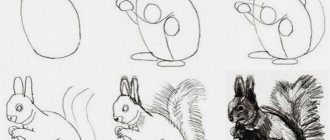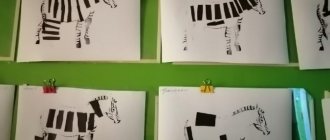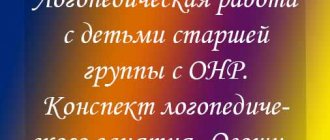Lesson on application on the topic “Vitamins for bear cubs”
Applique using an unconventional technique, without using scissors (crumpling, curling paper), is aesthetically and emotionally attractive for children, which is extremely useful for their overall development.
Goal: To educate and develop in children independence and patience, interest and love for art and creativity, through appliqué classes with non-traditional techniques.
We hypothesized: Applique classes with non-traditional techniques contribute to the sensorimotor development of children, which is the foundation of the child’s mental and physical development.
- Examination of fruits, still lifes depicting fruits.
- Conversation on the topic “What are the benefits of fruits for my body?”
- To develop children's skills in mastering non-traditional appliqué techniques. Teach children to represent fruit by crumpling and twisting paper. Reinforce knowledge about the health benefits of fruits.
- To develop children's fine motor skills and coordination in the eye-hand system. Develop a sense of shape and color, composition, as well as musical ear and imagination.
- To cultivate the desire for creative work and aesthetic taste through composition. To develop a caring attitude towards animals and a desire to help.
In our work, we relied on the works: A manual for classes with children “Magic Lumps” by A.V. Beloshistaya, O.G. Zhukova.
Demonstration material: sample bowl of fruit, T.S.O., tape recording of “Songs about Bears”, “Lullaby of the Bear”, telegram from Aibolit, parcel box.
Handouts: blanks of corrugated paper of red, orange and yellow, one piece each 12x12 cm, blue 10x10 cm one piece, eight pieces of green 5x5 cm, brown 2x4 cm two pieces, glue stick, sheet of A4 paper with depicting a vase, a wet napkin, oilcloth, caps and masks of polar bears.
Educator: - Guys, postman Pechkin brought us a musical letter. Let's listen to him.
Somewhere in this world, Where there is always frost, Bears rub their backs on the earth's axis.
Centuries float by, Sleeping under the ice of the sea. Bears rub against the axle - the earth turns.
Educator: Who is this song about?
Children: About polar bears.
Educator: Where do polar bears live?
Children: In the far North.
Educator: Today I will tell you a story.
“Far, far away in the Far North, where there is always winter and snow, polar bears live. They lived well and wonderfully, but then a misfortune befell them: the cubs fell ill. Some babies cough, others have stomach ache, and the temperature is so high that even their noses are hot.
Fortunately, their parents immediately remembered Dr. Aibolit, who treats all animals in the world. And the bears sent a telegram to Aibolit: “Dear Doctor Aibolit, come here quickly, quickly, we need to cure our children.” Aibolit immediately set off on his journey. First he rode in a car, then he raced on reindeer harnessed to a sleigh, then he was carried by dogs. He was in a hurry to get to the cubs.
But now the journey is over. Doctor Aibolit began to treat the patients: he gave some a potion, others large round tablets, and to others he put drops into the nose. And all the cubs recovered. Only they were very weak from their illnesses and did not play. They didn’t run, but everyone lay and looked pitifully at their parents and Doctor Aibolit.
- Oh, how come I didn’t think of that! - said Aibolit. – Children need, well, they just need vitamins. And there are a lot of vitamins in fruits. But where to get them, because fruits don’t grow in the North. What should we do now?!
And then he sent a telegram directly to us, to the kindergarten. (The teacher shows the “telegram”.)
"Dear Guys! Help the cubs recover! Please make some fruit for them! Thank you in advance, Doctor Aibolit.”
Educator: Well, guys, let's help the cubs finally recover?
Children: Of course we will help!
Educator: Now we will look at the fruits that we will make. (The teacher and the children look at the sample.)
What fruits do you see in the vase?
Children: Apples, plums, oranges, grapes.
Educator: Correct. And now I will show you how we will make fruit. To make apples, we will take yellow and red squares and make lumps out of them. To do this, we will crumple the paper into a ball with our fingers, apply glue to a place in the vase and glue our apples there. In order to make the petiole, we will make a flagellum from brown paper. To do this, we twist the flagellum with our fingers or roll the paper between our palms. We will make plums from blue paper, make lumps out of them and, just like apples, glue them to the vase. For the grapes, we take green paper and also make lumps out of them, glue them onto a vase in the shape of a triangle, and we will get a bunch of grapes. From the orange square we make an orange, just like apples.
The cubs lived in the thicket, twisting their heads, like this, like this, twisting their heads.
(Hands on waist, head turns left and right.)
The cubs were looking for honey, They shook the tree together, Like this, like this They rocked the tree together.
(Feet shoulder-width apart, arms up, torso tilted left and right.)
They waddled and drank water from the river, Like this, like this And they drank water from the river.
(We walk like bear cubs, bending forward.)
There is a swamp on the way, How can we cross it? Jump and jump, jump and jump, Jump and jump, my friend.
(Jumping on two legs while moving forward.)
And then they danced, raising their paws higher, Like this, like this, Raising their paws higher.
After physical education, the children begin to work.
During children’s independent work, the teacher provides children with individual assistance in case of difficulty.
After finishing the work, an analysis of children's work is carried out.
Educator: Guys, look at your work. Do you like them? Why? (Children’s answers. If you have any difficulties, help with questions.)
Educator: Guys, we made fruit for the cubs. We know that fruits contain a lot of vitamins. Let us send these fruits by parcel to the North Pole. (The teacher takes out a box for the parcel, the children put their work there.)
Guys, did you like today's lesson?
Educator: I liked the fact that you were very attentive during the lesson. They did their work well and carefully. The fruits turned out very bright, juicy, and you can immediately see that they contain a lot of vitamins. I also liked that you came to the aid of sick bear cubs. I want to thank you and treat you to fruit. Be healthy!
Source
Anatomy for kids: geometric shapes
The simplest instructions that will be understandable to children of primary and secondary kindergarten age. The work should be done under the supervision of an adult, who will voice each part of the body, show it to the baby himself and supervise the entire process of creating the craft. The more elements, the more difficult the task will be, so you should start with the simplest models.
From simple geometric shapes you can make a full-fledged postcard, the main character of which will be any family member.
Bright and cheerful images will certainly appeal to children of primary preschool age.
For those who are older, a unique mosaic composition is suitable. For example, from the proposed stencil you can make blanks for a future picture.
Invite your child to assemble a little man from the resulting elements, gluing them in a certain sequence on the base sheet.



